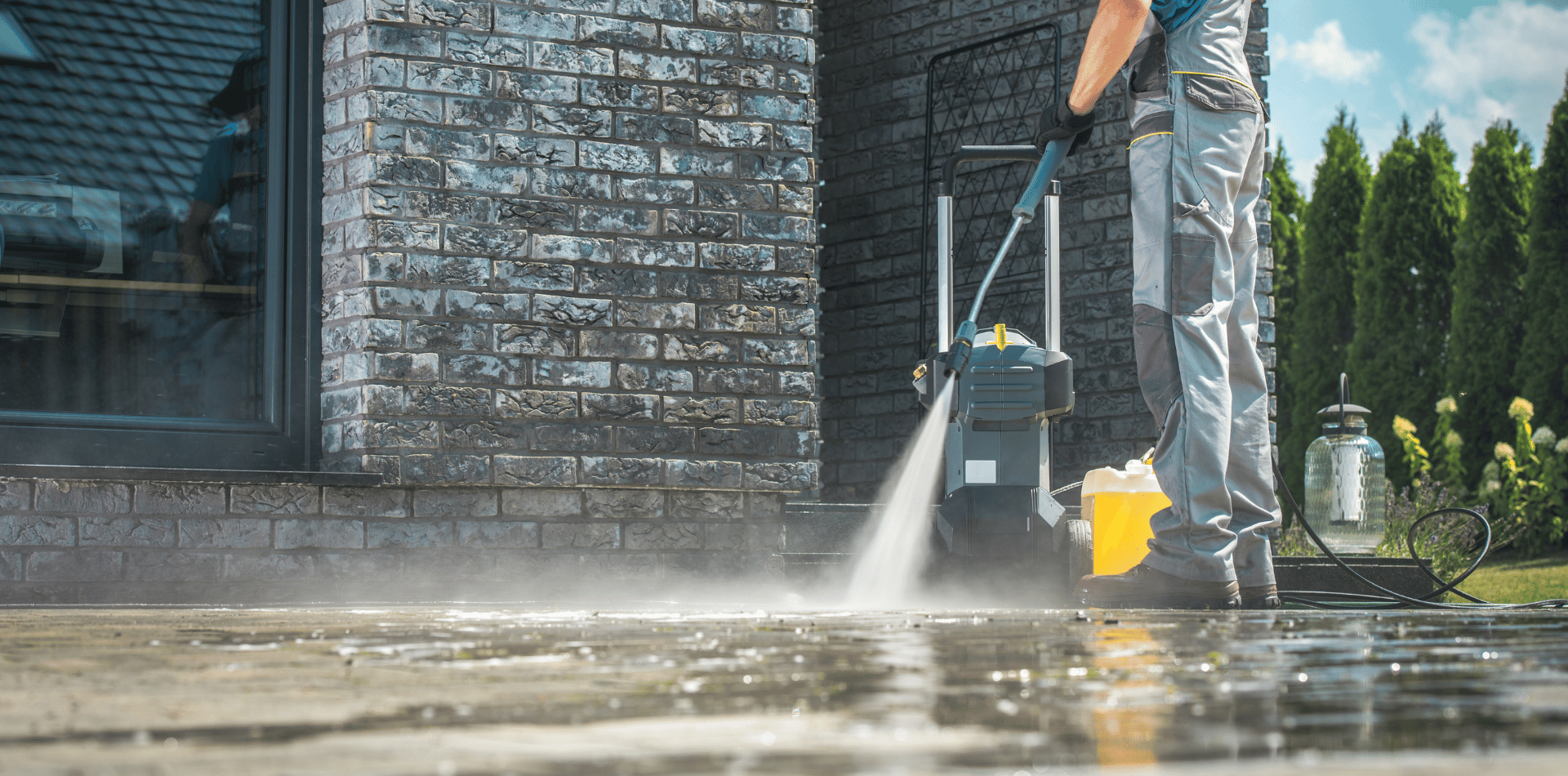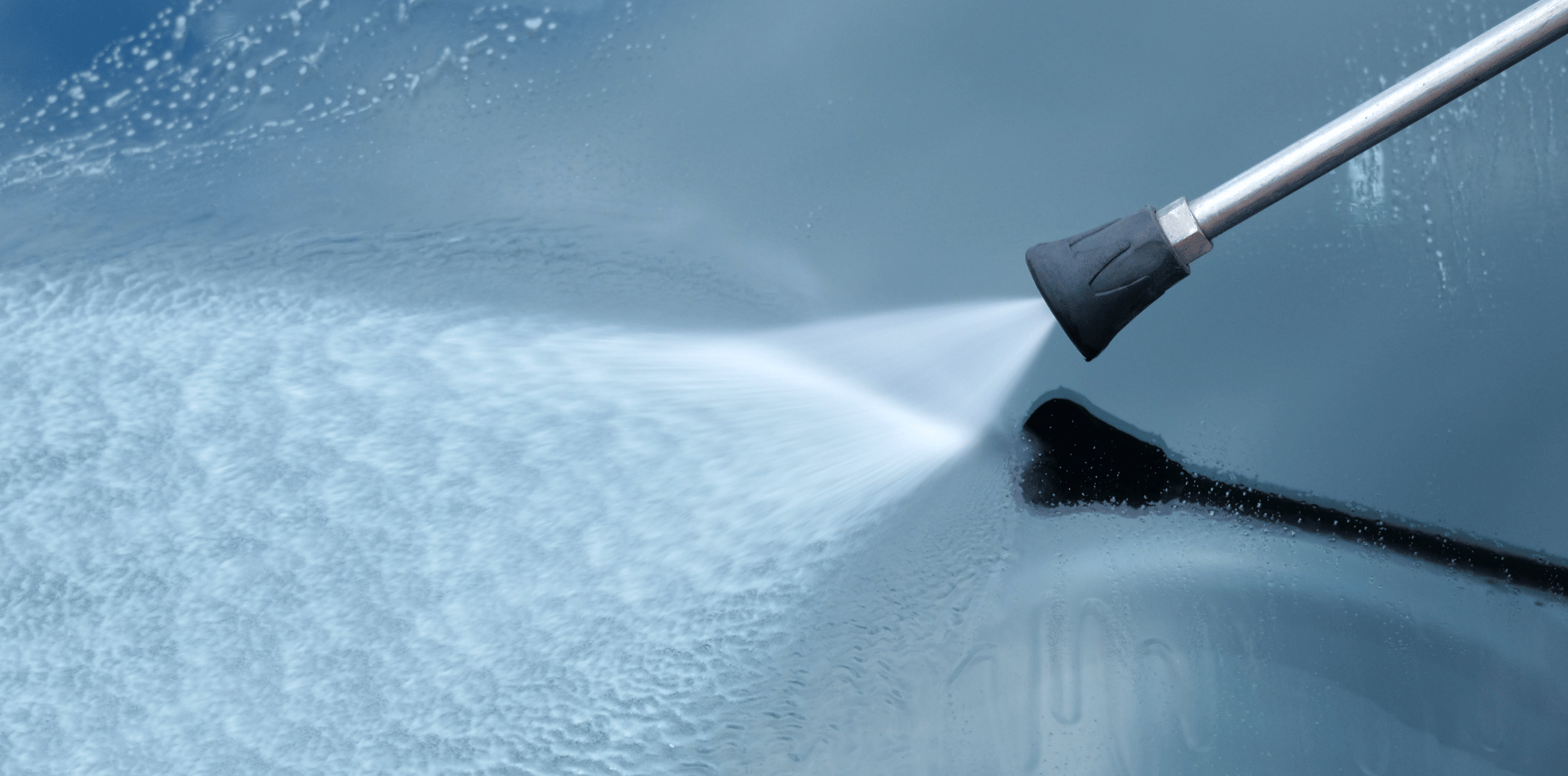Can you pressure wash a painted driveway
Can you pressure wash a painted driveway?

Pressure washing a painted driveway can be a safe and effective way to clean it, provided that certain precautions are taken to protect the integrity of the paint and the surface itself.
Here's a look at the best practices for this process:
Choosing the Right Equipment
Low Pressure Washer
Using a low-pressure washer for cleaning a painted driveway is a crucial step in preserving both the appearance and longevity of the paint. The ability to adjust the pressure settings is fundamental to ensure that the cleaning process does not inadvertently damage the driveway.
Here’s why using a low-pressure washer is so important, and some additional considerations for selecting and using such equipment:
Importance of Adjustable Pressure Settings
- Surface Protection: Painted surfaces are particularly susceptible to damage from high-pressure streams. The paint can be stripped or chipped away if the pressure is too intense. By using a washer that allows for pressure adjustments, you can tailor the force of the water to be strong enough to clean effectively without causing harm.
- Control Over Cleaning: Different levels of dirt or staining may require slightly different approaches. Adjustable settings mean you can use a stronger pressure for areas that are heavily soiled and reduce it for regular maintenance or lighter cleaning tasks.
Choosing the Right Pressure Washer
- PSI Ratings: Pressure washers come with different PSI (pounds per square inch) ratings. For painted surfaces, a washer with a maximum of 2000 PSI is usually sufficient. More importantly, it should offer the capability to operate at much lower PSI settings (around 1200-1600 PSI), which is safer for painted driveways.
- Flow Rate: The LPM (litres per minute) rate also plays a role. A higher LPM can increase cleaning efficiency by rinsing away debris more quickly, but it should be balanced with the appropriate PSI to prevent surface damage.
Techniques for Using Low-Pressure Washers
- Distance and Angle: When using a low-pressure washer, how you handle the wand can impact the cleaning effectiveness and safety. Hold the nozzle at a consistent angle and maintain a distance of at least 30 cm from the surface. Adjust your stance and the angle of the spray as needed to lift dirt without concentrating the force on one spot.
- Gradual Adjustment: Start with the lowest pressure setting and gradually increase it only if necessary. This approach helps you assess the cleaning effect on the paint without immediately exposing it to potentially harmful pressures.
Benefits of Using Low Pressure
- Reduced Risk of Damage: Lower pressures significantly reduce the likelihood of peeling or chipping the paint, which can lead to more extensive surface damage and the need for repairs.
- Increased Longevity of the Driveway: By preserving the integrity of the paint and underlying materials, low-pressure washing helps extend the lifespan of the driveway, reducing the frequency and cost of renovations.
Additional Considerations
- Test in an Inconspicuous Area: Before beginning the main cleaning, test the washer on a small, hidden section of the driveway to see how the painted surface reacts to the water pressure.
- Use of Detergents: Consider using a mild detergent with the low-pressure setting. The detergent can aid in loosening dirt and grime, making it easier to wash away without the need for high pressure.
Using a low-pressure washer with adjustable settings is a wise choice for maintaining a painted driveway. It offers a balance of effective cleaning and gentle handling, ensuring that the driveway remains clean and intact for years to come.

Appropriate Nozzles
Choosing the right nozzle for pressure washing is crucial, especially when cleaning sensitive surfaces like painted driveways. Different nozzles can dramatically alter the intensity and spread of the water spray, which affects both cleaning efficiency and the risk of damage to the paint.
Here’s a look at the importance of selecting appropriate nozzles, particularly focusing on nozzles with wider spray patterns for high-pressure cleaning of painted surfaces.
Understanding Nozzle Types
Pressure washer nozzles are typically colour-coded based on their spray pattern and angle:
- Red (0-degree): Produces a very concentrated, powerful jet of water. This nozzle is generally too harsh for painted surfaces and can easily cause damage.
- Yellow (15-degree): Offers a slightly wider spray that can be used for tougher cleaning jobs on more durable surfaces, not typically recommended for painted surfaces.
- Green (25-degree): Provides a balance between area coverage and pressure, making it suitable for general cleaning tasks on painted and delicate surfaces without causing harm.
- White (40-degree): Delivers a wider spray, which disperses the pressure over a larger area, making it ideal for gentle cleaning on painted, finished, or otherwise delicate surfaces.
Benefits of Wider Spray Patterns
- Even Pressure Distribution: Wider spray patterns spread the force of the water over a broader area, reducing the kpa impact at any single point on the surface. This helps prevent the stripping, peeling, or chipping of paint.
- Reduced Surface Stress: By mitigating the intensity of the water impact, wider nozzles like the 40-degree white and the 25-degree green minimise the stress on the painted driveway. This is crucial to avoid creating marks or etches on the surface.
- Enhanced Safety for Painted Surfaces: These nozzles reduce the likelihood of accidentally removing the paint or damaging the substrate, which is a common issue with more focused, higher-pressure nozzles.
Tips for Using Appropriate Nozzles
- Start With the Least Aggressive Option: When beginning your cleaning project, it’s advisable to start with the nozzle that offers the widest angle suitable for the job, assessing the effectiveness before possibly moving to a slightly more focused nozzle.
- Adjust Distance and Angle: Even with wider nozzles, the way you handle the pressure washer can affect the outcome. Start cleaning from a further distance and adjust as needed, always spraying at an angle that maximises coverage while minimising direct impact.
- Pre-test on a Small Area: Before fully committing to cleaning the entire driveway, test the chosen nozzle on a small, inconspicuous area. This allows you to see the effect on the paint and make any necessary adjustments to your technique or nozzle choice.
For maintaining the integrity of painted driveways while ensuring effective cleaning, opting for nozzles like the 40-degree white and 25-degree green is advisable. These nozzles offer a safer alternative by reducing the risk of damage due to their wider spray patterns. Properly selecting and using these nozzles can extend the life of the paint and the overall appearance of your driveway, contributing to both aesthetic appeal and material longevity.
Using Suitable Cleaning Solutions
Specialised Detergents
Using specialised detergents formulated for use with pressure washers on painted surfaces is an important aspect of safely and effectively cleaning a painted driveway. These detergents are designed to enhance the cleaning process without the risks associated with harsher chemicals.
Let's look at how specialised detergents work and the best practices for their application.
Benefits of Specialised Detergents
- Formulated for Safety and Efficiency: Detergents made for pressure washers and safe for painted surfaces contain ingredients that are effective at cleaning without damaging paint. They are typically less abrasive than standard detergents and are formulated to work at lower pressure settings.
- Enhanced Cleaning Power: These detergents help in breaking down and loosening dirt, oil, and other substances that water alone might not remove. This makes them particularly useful for tackling stained or heavily soiled areas.
- Biodegradable Options: Many of these detergents are environmentally friendly, biodegradable, and designed to be safe for plants and animals around your home, which is a crucial consideration when washing surfaces that run off into your yard or garden.
Proper Application Techniques
- Low-Pressure Application: To avoid damaging the paint, apply the detergent using a low-pressure setting on your pressure washer. This setting uses the equipment to spread the detergent evenly across the surface without the force that could strip paint.
- Pre-soaking the Surface: Once applied, it’s beneficial to let the detergent sit on the surface for several minutes. This dwelling time is crucial as it allows the cleaning agents in the detergent to penetrate and break down the dirt and grime.
- Consistent Coverage: Ensure that the detergent is spread evenly across the driveway. Inconsistent application can lead to patchy cleaning results and may leave some areas less clean than others.
Additional Tips for Using Detergents
- Choosing the Right Detergent: Select a detergent that specifies it is safe for painted surfaces. Check the product descriptions and labels for any mention of suitability for painted or delicate surfaces.
- Testing Before Full Application: As with any cleaning agent, it’s wise to test the detergent on a small, inconspicuous area of your driveway. This helps ensure that the detergent won’t discolor or damage the paint.
- Rinsing Thoroughly: After the detergent has had time to work on the dirt, thoroughly rinse off the surface with clean water. Remaining detergent can attract dirt or even degrade the paint over time if not completely washed away.
- Follow Manufacturer’s Instructions: Always adhere to the usage instructions provided by the manufacturer. This includes recommendations on dilution ratios, application methods, and safety precautions.
Using specialised detergents in conjunction with a pressure washer can significantly improve the cleaning process of a painted driveway while minimising the risk of damage. By choosing the right products and applying them correctly, you ensure that your driveway remains clean and vibrant without compromising the integrity of the paint. This approach not only yields better cleaning results but also extends the life of the paint and the material beneath.
Technique and Approach
When pressure washing a painted driveway, employing the correct technique and approach is as important as selecting the right equipment and cleaning agents. Proper handling ensures efficient cleaning without damaging the driveway’s paint.
Let's look into the methods for even cleaning and special attention to fragile areas, providing a comprehensive guide to best practices.
Even Cleaning Technique
- Start from a Safe Distance: Begin the cleaning process from a safe distance, approximately 30 to 40 cm away from the driveway surface. This initial distance helps to gauge the effectiveness of the water pressure without causing immediate damage.
- Gradual Approach: If the initial pressure does not adequately clean the surface, slowly move closer in small increments, but do not decrease the distance to less than 30 cm. This minimises the risk of the water pressure being too intense for the paint.
- Consistent Sweeping Motion: Use a steady, sweeping motion with the spray wand. Move it side to side or up and down in a controlled manner, covering the surface evenly. This method helps to prevent the pressure from focusing on one spot, which could strip the paint or etch the concrete.
- Overlap Each Stroke: As you move the spray, overlap each previous stroke by several cm. This overlap ensures that no areas are missed and that the cleaning effect is uniform across the entire surface.
Focus on Fragile Areas
- Identify Vulnerable Points: Pay special attention to edges, corners, and any decorative details. These areas are often more exposed and have less structural integrity, making them prone to damage.
- Use a Gentler Spray: In these sensitive areas, switch to a nozzle that provides a gentler, broader water spray, such as a 40-degree nozzle. The reduced force will still be effective at cleaning but less likely to cause paint damage.
- Modify the Technique: Adjust your cleaning technique by increasing the distance from the surface when dealing with these fragile areas. Additionally, angle the spray so that the water hits these spots at a reduced intensity.
- Inspect Regularly: As you clean, periodically stop to inspect the areas you've washed, particularly the fragile edges and corners. Look for any signs of paint lifting or surface damage and adjust your technique accordingly if necessary.
Additional Considerations
- Time of Day and Weather: Avoid pressure washing in direct sunlight or on very hot days, as this can cause the surface to dry too quickly, potentially leaving detergent residues or uneven cleaning marks.
- Regular Breaks: Take breaks during extensive cleaning sessions to review your progress and check the equipment. This also helps prevent fatigue, which can lead to uneven cleaning or accidental damage due to careless handling.
- Post-Cleaning Inspection: After cleaning, do a thorough walk-around to ensure all areas are evenly cleaned and no detergent residues are left behind. This is also an ideal time to check for any potential damage caused during the washing process.
By mastering these techniques and approaches, you can ensure that your painted driveway is not only clean but also remains in good condition, preserving its appearance and longevity. These practices help mitigate the risks associated with high-pressure washing and are essential for maintaining delicate painted surfaces.
Rinsing and Post-Care
Thorough Rinsing
Thorough rinsing is a crucial step in the pressure washing process, especially for painted driveways where residual detergents and debris can cause damage over time if not properly removed.
Here's how to effectively rinse your driveway:
- Use Clean Water: Ensure that the water you use for rinsing is clean and free from any previously used detergents or chemicals. This helps in effectively washing away any residue without adding more contaminants to the surface.
- Consistent Pressure and Coverage: Use a consistent, moderate pressure setting to rinse the driveway. The goal is to cover the entire area uniformly, ensuring that no spots are missed where detergent or dirt could linger.
- Safe Distance and Technique: Maintain a minimum distance of about 30 cm from the surface during rinsing. Use a sweeping motion similar to the cleaning phase, which helps in covering large areas efficiently while minimizing the risk of water pressure damage.
- Final Inspection: After rinsing, take a moment to inspect the driveway thoroughly. Look for any areas that may still have soap suds or visible debris and rinse these areas again if necessary.
Regular Maintenance
Maintaining a painted driveway involves regular inspections and timely interventions to address any emerging issues.
This proactive approach helps extend the life of the driveway and keeps it looking its best:
- Routine Inspections: Schedule regular inspections of your driveway. Look for any signs of wear such as cracking, peeling, or fading paint. Early detection of these issues can prevent more extensive damage.
- Damage Repair: If you notice small chips or general wear in the paint, consider touching up these areas promptly. Use a paint that matches the existing colour and is suitable for outdoor, high-traffic areas.
- Protective Sealant: Applying a sealant can provide an extra layer of protection for the painted surface. Sealants help in guarding against moisture, UV rays, and chemicals that might otherwise degrade the paint more quickly.
- Clean Regularly: Besides pressure washing, regular cleaning with less intense methods can help maintain the appearance of the driveway. Sweeping and occasional rinsing with a garden hose can remove debris that might scratch or degrade the paint.
- Avoid Harsh Chemicals: When doing any regular cleaning, avoid using harsh chemicals that could strip the paint. Stick to mild cleaners and ensure any cleaning agents used are suitable for painted surfaces.
Thorough rinsing and regular maintenance are key components of effectively managing a painted driveway. These practices not only ensure the cleanliness of the driveway but also play a critical role in preserving the paint and substrate integrity. By implementing a routine that includes careful cleaning, rinsing, and periodic maintenance, you can enjoy a vibrant and durable driveway for years to come. This approach not only enhances the curb appeal of your property but also protects your investment in the driveway's aesthetic and structural quality.



Let’s talk.
Fill out the form, or call us on 0438 248 833 to set up a meeting.
We will get back to you as soon as possible.
Please try again later.
Contact
Bossley Park, NSW
Site Designed and Managed by Kaptol Media


